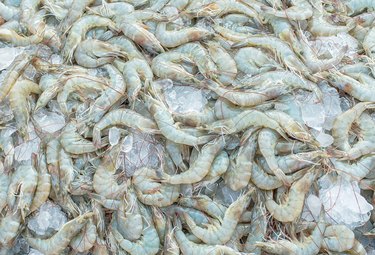
In the United States, Americans don't typically eat the head meat of any animal, much less the entire head. However, for centuries the Chinese and the French have eaten entire shrimp, claiming that the head is the tastiest part of the shrimp. Whole shrimp can be boiled, sautéed or stir-fried shell-on, and then peeled and eaten in their entirety. Although the peeling and de-veining after cooking creates more work for the diner, it is worth it for the more intense flavor that you gain by cooking the shrimp in the shell with the head still attached.
Boiled Whole Shrimp
Video of the Day
Step 1
Bring 10 cups of water to a boil over high heat in a stockpot. Add 1 tsp. salt.
Video of the Day
Step 2
Place the whole shrimp, shell still on, into the boiling water. Boil the shrimp for three to five minutes or until the shrimp begin to curl and turn bright pink.
Step 3
Remove the shrimp from the water with the skimmer. Serve them hot or peel and de-vein them for the diners before you serve them.
Sautéed Whole Shrimp
Step 1
Heat 3 tbsp. olive oil or butter in the skillet over high heat until the oil or butter is hot.
Step 2
Reduce the heat to medium-high and add the whole, shell-on shrimp to the pan a few at a time; sauté them for three minutes or until the shrimp turn bright pink.
Step 3
Remove the shrimp and place them into a covered dish for three minutes to allow them to steam to finish the cooking process.
Step 4
Serve the shrimp hot in the shell, or shell and de-vein them before serving them.
Stir-Fried Whole Shrimp
Step 1
Pour the 3 tbsp. olive oil into the wok. Heat the oil over high heat on your stove top.
Step 2
Add the shrimp and sauté them for three minutes, or until the shells turn pink.
Step 3
Add vegetables and sauté the mixture for two minutes. A variety of vegetables complement shrimp, but some common choices are broccoli, onions, mushrooms, bean sprouts or water chestnuts. At the end of the cooking time, the vegetables should be tender but not soft.
Step 4
Reduce the heat to low and add the sauce. Good choices for sauce include spicy Szechwan sauce, tangy sweet and sour sauce, or a sweet teriyaki sauce. Stir to coat the vegetables. Sauté until the sauce is warm.
Step 5
Serve the stir-fried shrimp hot over rice or noodles. Allow the diners to peel and eat the shrimp themselves.
Things You'll Need
2 lbs. whole shrimp
10 cups of water for boiling
1 tsp. salt
3 tbsp. olive oil or butter for sautéing or stir frying
2 cups vegetables of your choice for stir-frying
1/2 cup sauce of your choice for stir-frying
4 cups rice or noodles for stir-fry
Stockpot
Skimmer
Skillet
Spatula
Wok
- "Fat of the Land: Adventures of a 21st Century Forager"; Langdon Cook; 2009
- "On Food and Cooking: The Science and Lore of The Kitchen"; Harold McGee; 2004
- "Bistro Laurent Tourondel: New American Bistro Cooking"; Laurent Tourondel, et al; 2007
- "When French Women Cook: A Gastronomic Memoir with Over 250 Recipes"; Madeleine Kamman; 2010
- "Protein Power: The High-Protein/Low-Carbohydrate Way to Lose Weight, Feel ... "; Michael R. Eades, et al.; 1999